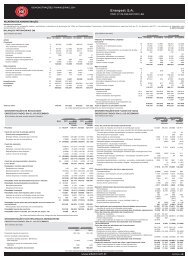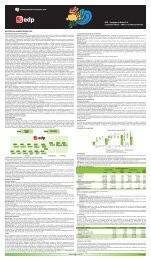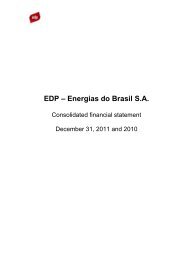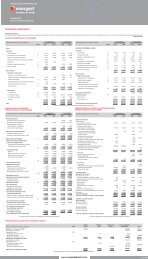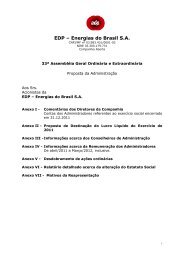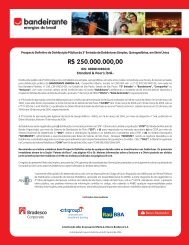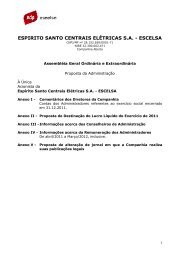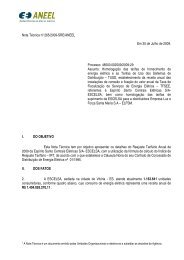Energias do Brasil SA and subsidiaries - EDP no Brasil | Investidores
Energias do Brasil SA and subsidiaries - EDP no Brasil | Investidores
Energias do Brasil SA and subsidiaries - EDP no Brasil | Investidores
Create successful ePaper yourself
Turn your PDF publications into a flip-book with our unique Google optimized e-Paper software.
<strong>EDP</strong> – ENERGIAS DO BRASIL S.A.<br />
NOTES TO THE FINANCIAL STATEMENTS<br />
DECEMBER 31, 2009 AND 2008<br />
(Amounts expressed in thous<strong>and</strong>s of Reais, unless otherwise indicated)<br />
revaluation are recorded in net income for the period, excepting as refers to the cash flow hedge derivatives. The<br />
recognition of variations of fair value of the hedge derivatives, in net income for the period, depends on the nature of<br />
the covered risk <strong>and</strong> on the hedge model used.<br />
Hedge accounting<br />
The Company <strong>and</strong> its <strong>subsidiaries</strong> use financial instruments of hedge of the interest rate, foreign exchange variation<br />
<strong>and</strong> financing risk. The derivatives that <strong>do</strong> <strong>no</strong>t qualify as hedge derivatives are recorded as trading derivatives.<br />
The hedge derivatives are recorded at fair value <strong>and</strong> gains or losses are recognized according to the hedge<br />
accounting model a<strong>do</strong>pted, as follows:<br />
i) there is formal <strong>do</strong>cumentation of the hedge on the start date of the relationship;<br />
ii) the hedge is expected to be highly effective;<br />
iii) the hedge effectiveness can be measured reliably;<br />
iv) the hedge is evaluated on a continual basis <strong>and</strong> effectively determined as being highly effective throughout the<br />
financing period; <strong>and</strong><br />
v) in relation to the hedge of an anticipated transaction, this must be highly probable <strong>and</strong> must present exposure to<br />
cash flow variations that could ultimately affect the result.<br />
Cash flow hedge<br />
The effective part of the variations of the fair value of designated derivatives that qualify as cash flow hedge is<br />
recognized in shareholders' equity – asset revaluation reserve. The gains or losses of the ineffective portion of the<br />
hedge relation are recognized by counter entry in net income for the period, at the time the ineffectiveness occurs.<br />
The amounts accumulated in shareholders' equity are passed through net income in the periods in which the<br />
hedged item affects results. However, when the predicted transaction that is hedged results in the recognition of a<br />
<strong>no</strong>n-financial asset or liability, gains or losses recorded in shareholders' equity are recognized by counter entry of<br />
the initial cost of the asset or liability.<br />
When a hedge instrument expires or is sold, or when the hedge relation fails to fulfill the criteria for hedge<br />
accounting, any accumulated gain or loss recorded in shareholders' equity on the date is kept in shareholders' equity<br />
until the foreseen transaction is recognized in net income. When the transaction is <strong>no</strong>t expected to take place, the<br />
accumulated gains or losses recorded by counter entry of shareholders' equity are immediately recognized in net<br />
income for the period.<br />
Effectiveness<br />
For a hedge relation to be classified as such, its effectiveness should be demonstrated. Hence the Company <strong>and</strong> its<br />
<strong>subsidiaries</strong> carry out prospective tests on the start date of the hedge relation <strong>and</strong> on each balance sheet date,<br />
perform tests prospectively <strong>and</strong> retroactively in order to demonstrate its effectiveness <strong>and</strong> showing that alterations in<br />
the fair value of the hedged item are offset by alterations in the fair value of the hedge instrument, with respect to the<br />
hedged risk. Any ineffectiveness determined is recognized in results as soon as it occurs.<br />
v) Foreign currency<br />
The functional currency of the Company <strong>and</strong> its <strong>subsidiaries</strong> is the Real, according to the rules described in CPC 02 -<br />
Impacts on the Changes in Exchange Rates <strong>and</strong> Translation of Financial Statements, approved by CVM Resolution nº<br />
534.<br />
Transactions in foreign currency, that is, all those that are <strong>no</strong>t performed in the functional currency, are translated by the<br />
exchange rate of the dates of each transaction. Monetary assets <strong>and</strong> liabilities in foreign currency are translated into the<br />
functional currency at the foreign exchange rate of the closing date. Gains <strong>and</strong> losses of variations in the exchange rates<br />
on monetary assets <strong>and</strong> liabilities are recognized in the statement of income. Non-monetary assets <strong>and</strong> liabilities<br />
acquired or contracted in foreign currency are translated with a basis on the exchange rates of the dates of the<br />
transactions or on the dates of valuation at the fair value when this is used.<br />
3.3 - Consolidated financial statements<br />
The consolidated financial statements were prepared in accordance with the st<strong>and</strong>ards established by CVM Instruction<br />
247, of March 27, 1996 <strong>and</strong> subsequent amendments, covering <strong>EDP</strong> - <strong>Energias</strong> <strong>do</strong> <strong>Brasil</strong> S.A., its <strong>subsidiaries</strong> (as<br />
described in Note 1). The accounting criteria a<strong>do</strong>pted in their/its determination were applied uniformly among the various<br />
companies of the group .<br />
46



